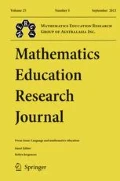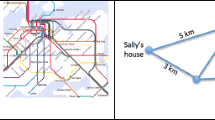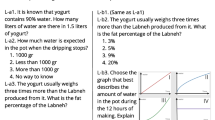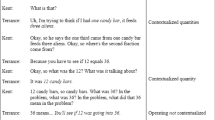Abstract
Teachers are encouraged to connect mathematic instruction to the real-world by posing tasks that are situated in rich, relevant contexts, but research has found that many teachers integrate contextual problems (CPs) as motivators rather than as supports for conceptual development. To provide insight into how teachers’ conceptions about CPs shift as they teach through contextual problem solving, we interviewed six teachers before and after they taught from a unit designed from principles of realistic mathematics education, an instructional design theory which positions realistic contexts as learning supports. Our findings indicate that teachers initially viewed CPs primarily as affective or motivating enhancements, but after teaching the RME unit with university-based support, the teachers articulated integrated understandings of how CPs can function as supports for conceptual development. The teachers articulated how CPs provide initial access, sites for progressive representational formalization, and references to which students can fall back in order to interpret subsequent tasks. The authors identify connections between these ideas and the support provided by the university team and the teachers’ guides.
Similar content being viewed by others
References
Artigue, M., & Blomhøj, M. (2013). Conceptualizing inquiry-based education in mathematics. ZDM, 45(6), 797–810.
Ball, D. L., & Cohen, D. K. (1996). Reform by the book: what is-or might be- the role of curriculum materials in teacher learning and instructional reform? Educational Researcher, 25(9), 6–14.
Beswick, K. (2011). Putting context in context: an examination of the evidence for the benefits of ‘contextualised’ tasks. International Journal of Science and Mathematics Education, 9(2), 367–390.
Cai, J. (2003). What research tells us about teaching mathematics through problem solving. Research and Issues in Teaching Mathematics through Problem Solving, 241–254. Reston, VA: National Council of Teachers of Mathematics.
Carpenter, T. P., Fennema, E., & Franke, M. L. (1996). Cognitively guided instruction: a knowledge base for reform in primary mathematics instruction. The Elementary School Journal, 97(1), 3–20.
Carpenter, T. P., Franke, M. L., Jacobs, V. R., Fennema, E., & Empson, S. B. (1998). A longitudinal study of invention and understanding in children’s multidigit addition and subtraction. Journal for Research in Mathematics Education, 29(1), 3–20.
Chapman, O. (2006). Classroom practices for context of mathematics word problems. Educational Studies in Mathematics, 62(2), 211–230.
Chapman, O. (2009). Teachers’ conceptions and use of mathematical contextual problems in Canada. In L. Verschaffel, B. Greer, W. Van Dooren, & S. Mukhopadhyay (Eds.), Words and worlds (pp. 227–244). Rotterdam: Sense Publishers.
Chavez, O. L. (2003). From the textbook to the enacted curriculum: textbook use in the middle school mathematics classroom [Unpublished doctoral dissertation]. University of Missouri, Columbia.
Cobb, P., Gravemeijer, K., Yackel, E., McClain, K., & Whitenack, J. (1997). Mathematizing and symbolizing: the emergence of chains of signification in one first-grade classroom. In D. Kirshner & J. A. Whitson (Eds.), Situated cognition: social, semiotic, and psychological perspectives. Hillsdale: Lawrence Erlbaum.
Cobb, P., Wood, T., Yackel, E., Nicholls, J., Wheatley, G., Trigatti, B., & Perlwitz, M. (1991). Assessment of a problem-centered second-grade mathematics project. Journal for Research in Mathematics Education, 22(1), 3–29.
Collopy, R. (2003). Curriculum materials as a professional development tool: how a mathematics textbook affected two teachers’ learning. The Elementary School Journal, 103(3), 287–311.
Davis, E. A., & Krajcik, J. S. (2005). Designing educative curriculum materials to promote teacher learning. Educational Researcher, 34(3), 3–14.
Drake, C., & Sherin, M. G. (2008). Developing curriculum vision and trust. In J. T. Remillard, B. A. Herbel-Eisenmann, & G. M. Lloyd (Eds.), Mathematics teachers at work: connecting curriculum materials and classroom instruction (pp. 321–337). New York: Routledge.
Fennema, E., Carpenter, T. P., Franke, M. L., Levi, L., Jacobs, V. R., & Empson, S. B. (1996). A longitudinal study of learning to use children’s thinking in mathematics instruction. Journal for Research in Mathematics Education, 27(4), 403–434. https://doi.org/10.2307/749875.
Freudenthal, H. (1973). Mathematics as an educational task. Dordrecht: Reidel.
Freudenthal, H. (1991). Revisiting mathematics education: China lectures. Dordrecht: Kluwer Academic Publishers.
Fuson, K. C., Carroll, W. M., & Drueck, J. V. (2000). Achievement results for second and third graders using the standards-based curriculum everyday mathematics. Journal for Research in Mathematics Education, 29(1), 277–295.
Gainsburg, J. (2008). Real-world connections in secondary mathematics teaching. Journal of Mathematics Teacher Education, 11(3), 199–219.
Gainsburg, J. (2009). How and why secondary mathematics teachers make (or don’t make) real-world connections in teaching. In L. Verschaffel, B. Greer, W. Van Dooren, & S. Mukhopadhyay (Eds.), Words and worlds: Modelling verbal descriptions of situations (pp. 265–282). Rotterdam: Sense Publishers.
González, G. (2017). Teachers’ understandings of realistic contexts to capitalize on students’ prior knowledge. School Science and Mathematics, 117(7), 329–340.
Grant, T. J., Kline, K., Crumbaugh, C., Kim, O. K., & Cengiz, N. (2009). How can curriculum materials support teachers in pursuing student thinking during whole-group discussions. In J. T. Remillard, B. A. Herbel-Eisenmann, & G. M. Lloyd (Eds.), Mathematics teachers at work: connecting curriculum materials and classroom instruction (pp. 17–36). New York: Routledge.
Gravemeijer, K. (1999). How emergent models may foster the constitution of formal mathematics. Mathematical Thinking and Learning, 1(2), 155–177.
Hiebert, J., & Wearne, D. (1993). Instructional tasks, classroom discourse, and students’ learning in second-grade arithmetic. American Educational Research Journal, 30(2), 393–425.
Lambdin, D. V., & Preston, R. V. (1995). Caricatures in innovation: teacher adaptation to an investigation-oriented middle school mathematics curriculum. Journal of Teacher Education, 46(2), 130–140.
Lappan, G., Phillips, E., Fey, J., & Friel, S. (2014). Connected mathematics project 3. Boston: Pearson.
Lee, J.-E. (2012). Prospective elementary teachers’ perceptions of real-life connections reflected in posing and evaluating story problems. Journal of Mathematics Teacher Education, 15(6), 429–452.
Miles, M. B., Huberman, A. M., & Saldana, J. (2014). Qualitative data analysis: a methods sources (3rd ed.). Los Angeles, CA: Sage SAGE Publications Ltd.
Nathan, M. J., Long, S. D., & Alibali, M. W. (2002). The symbol precedence view of mathematical development: a corpus analysis of the rhetorical structure of textbooks. Discourse Processes, 33(1), 1–21.
National Council of Teachers of Mathematics. (2000). Principles and standards for school mathematics. Reston: Author.
National Council of Teachers of Mathematics. (2014). Principles to actions: ensuring mathematical success.
Pierce, R. U., & Stacey, K. C. (2006). Enhancing the image of mathematics by association with simple pleasures from real world contexts. ZDM, 38, 214–225.
Rasmussen, C. L., & King, K. D. (2000). Locating starting points in differential equations: a realistic mathematics education approach. International Journal of Mathematical Education in Science and Technology, 31(2), 161–172.
Reinke, L. T. (2019). Contextual problems as conceptual anchors: an illustrative case. Research in Mathematics Education. Advance online publication. https://doi.org/10.1080/14794802.2019.1618731
Remillard, J. T. (2000). Can curriculum materials support teachers’ learning? Two fourth-grade teachers’ use of a new mathematics text. The Elementary School Journal, 100(4), 331–350.
Remillard, J. T., & Bryans, M. B. (2004). Teachers’ orientations toward mathematics curriculum materials: implications for teacher learning. Journal for Research in Mathematics Education, 35(5), 352–388.
Ridgway, J., Zawojewski, Z., Hoover, M., & Lambdin, D. (2003). Student attainment in the connected mathematics curriculum. In S. Senk & D. Thompson (Eds.), Standards-based school mathematics curricula: what are they? What do they Do? Mahwah: Lawrence Erlbaum Associates.
Romberg, T. A., & Shafer, M. C. (2003). Mathematics in Context (MiC)—Preliminary evidence about student outcomes. In S. Senk & D. Thompson (Eds.), Standards-based school mathematics curricula: What are they (pp. 225–250). Mahwah: Lawrence Erlbaum associates.
Schneider, R. M., & Krajcik, J. (2002). Supporting science teacher learning: the role of educative curriculum materials. Journal of Science Teacher Education, 13(3), 221–245.
Schroeder, T. L., & Lester, F. K. (1989). Developing understanding in mathematics via problem solving. In P. R. Trafton (Ed.), New directions for elementary school mathematics (pp. 31–42). Reston: NCTM.
Smith, M., & Stein, M.K. (2011). 5 practices for orchestrating productive mathematics discussions. Reston: National Council of Teachers of Mathematics.
Stephan, M., & Akyuz, D. (2012). A proposed instructional theory for integer addition and subtraction. Journal for Research in Mathematics Education, 43(4), 428–464.
Stephan, M., McManus, G., Smith, J., & Dickey, A. (n.d.). Ratio and Rates. Retrieved from http://cstem.uncc.edu/sites/cstem.uncc.edu/files/media/Ratio T Manual.pdf.
Stephan, M., Pugalee, D., Cline, J., & Cline, C. (2016). Lesson imaging in math and science: anticipating student ideas and questions for deeper STEM learning. Alexandria: ASCD.
Stipek, D. J., Givvin, K. B., Salmon, J. M., & MacGyvers, V. L. (2001). Teachers’ beliefs and practices related to mathematics instruction. Teaching and Teacher Education, 17(2), 213–226.
Sullivan, P., Clarke, D., & Clarke, B. (2012). Teaching with tasks for effective mathematics learning (Vol. 9). Springer Science & Business Media.
Treffers, A. (1987). Three dimensions: a model of goal and theory description in mathematics instruction-the Wiskobas Project. Reidel, Dordrecht, The Netherlands.
Wijaya, A., van den Heuvel-Panhuizen, M., & Doorman, M. (2015). Teachers’ teaching practices and beliefs regarding context-based tasks and their relation with students’ difficulties in solving these tasks. Mathematics Education Research Journal, 27(4), 637–662.
Wood, T., & Sellers, P. (1997). Deepening the analysis: longitudinal assessment of a problem-centered mathematics program. Journal for Research in Mathematics Education, 28(2), 163–186.
Author information
Authors and Affiliations
Corresponding author
Additional information
Publisher’s note
Springer Nature remains neutral with regard to jurisdictional claims in published maps and institutional affiliations.
Rights and permissions
About this article
Cite this article
Reinke, L.T., Casto, A. Motivators or conceptual foundation? Investigating the development of teachers’ conceptions of contextual problems. Math Ed Res J 34, 113–137 (2022). https://doi.org/10.1007/s13394-020-00329-8
Received:
Revised:
Accepted:
Published:
Issue Date:
DOI: https://doi.org/10.1007/s13394-020-00329-8




